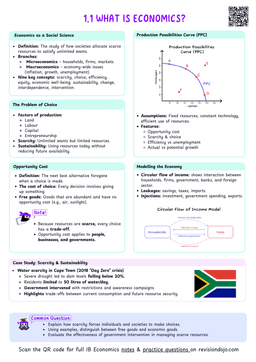Origin of economic ideas in a historical context
NoteThis section will briefly introduce the evolution of economics since the 18th century. Being very introductory, it will superficially touch on the main concepts that evolved through each era of economics as a science.
All the concepts mentioned here at an introductory level will be developed further into the syllabus. Do not worry if a concept is not fully understood now, come back to it after you are done with the syllabus!
18th century: Adam Smith and laissez faire
Adam Smith (1723-1790), often called the "Father of Economics," introduced foundational ideas to modern economics in his book, The Wealth of Nations (1776).
Adam Smith argued for minimal government intervention. He mainly advocated for:
- Invisible hand: market competition guides resources to their most efficient uses through self-interested actions.
- Division of labor: specialization in tasks boosts productivity and promotes economic growth.
- Free trade: countries should produce goods where they have an absolute advantage, fostering mutual benefits.
Adam Smith advocated for minimal government intervention in the economy, a concept closely aligned with the term laissez-faire (meaning "let it do" in French), popularised by French Physiocrats in the 19th century.
19th century economics
The development of classical economic thought
The 19th century saw significant advancements in economic thinking, building on the foundational ideas of Adam Smith. The ideas develop during this century are referred to as classical economics.
- Economists of this era focused on issues such as:
- Economic growth: understanding how economies expand over time.
- Income distribution: analyzing how wealth is allocated within societies.
- Key contributors to 19th century economics include:
- David Ricardo: Explored theories of value, trade, and income distribution.
- Jeremy Bentham and John Stuart Mill: Introduced utilitarianism, blending ethics with economics.
Classical microeconomics: utility
In the 19th century, philosophers like Jeremy Bentham and John Stuart Mill developed utilitarianism.
- They emphasized the actions that maximize happiness for the greatest number.
- Through this, the idea of utility was introduced in economics. Economist began to seeking utility maximisation.
Utility
The satisfaction obtained from consuming a good or service.
The concept of margin
Classical economists were concerned with the concept of value. They wondered what exactly determined the pricing of goods and services:
- Originally, economists believed it was the amount of labour than the production of each good and service required was the factor that determined its pricing.
- However, when the concept of utility was introduced, this idea was re-evaluated.
Economist agreed that utility was central to the idea of the value of a good determining its pricing. However:
- What is significant is not the overall satisfaction gained from consuming a good, but the additional satisfaction derived from consuming one more unit of it.
- This concept is referred to as marginal utility.
Marginal utility
The satisfaction obtained from consuming one more unit of a good or service.
Curious fact
The economists that developed the concept of marginal utility were:
- Léon Walras (French).
- Stanly Jevons (Enlgish).
- Carl Menger (Austrian).
They all arrived to the same concept of marginal utility determining the prices of goods independently.
Classical macroeconomics (Say's Law)
Classical economists sought to understand:
- How could economies maintain full employment of their resources?
- How could economies ensure that all goods and services produced were consumed?
Originally, it was believed that the market system inherently adjusted itself to prevent prolonged periods of unemployment (or economic stagnation). This concept, formalised by Jean Baptiste Say,
This perspective was formalised by Jean-Baptiste Say, became the building principle of classical macroeconomics: Say’s Law. This law suggests that supply creates its own demand:
- The production of goods and services generates income for households, enabling them to purchase what is produced.
- This continuous flow of income and spending ensures that all output is eventually bought.
Does Say's Law remind you of the circular flow of income model?
Marxist critique of classical economic thought
Karl Marx presented a systematic critique of capitalism in his work "Capital: Critique of Political Economy." Marx:
- Viewed capitalism as a system driven by the private ownership of production and the endless pursuit of profit.
- Built upon the labour theory of value. However, he observed a gap between:
- The wages paid to workers.
- The actual price of goods, which he termed surplus value.
- The surplus value is the profit earned by factory owners.
- Marx argued that the surplus value arose from the exploitation of workers in order to maximise profits.
Marx ideas were developed in the 19th-century, during the industrial revolution. He coexisted with the industrial England of the time, where poor working conditions were well-documented by contemporary authors like Charles Dickens.
Do you think historical events contribute to the evolution of social sciences like economics? What about natural sciences?
Marx argued that capitalism evolved from feudalism. He further argued that capitalism was inherently unstable because:
- Intense competition forces capitalists to invest in machinery to reduce labor costs.
- Over time, this reduces the surplus value generated by labor, leading to falling profits.
- Increasing automation causes unemployment and poverty among workers, intensifying class struggles.
- Marx argued that capitalism's colapse would eventually give way to communism.
Marx predicted that capitalism would collapse, leading to communism: a system where production is collectively owned by the people. However:
- His vision of communism never materialized in the way he anticipated.
- Capitalism has endured, though periodically experiencing crises like the Great Depression and the 2008 financial crisis.


